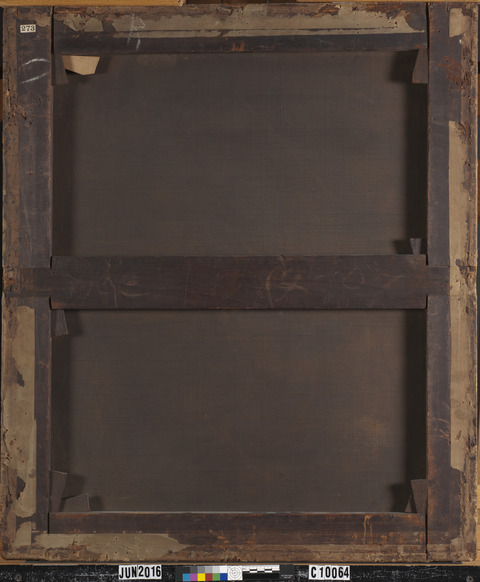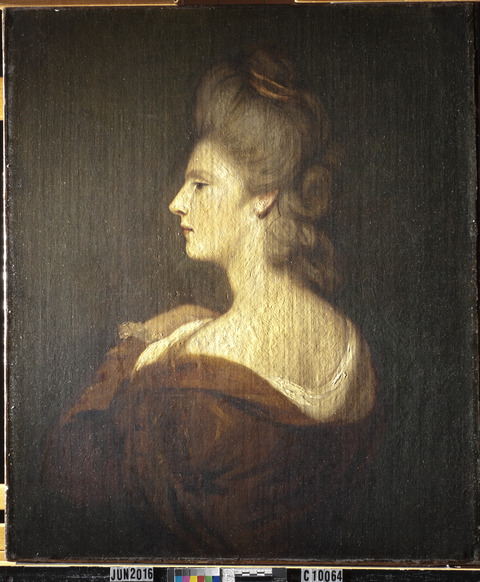Overview
Accession number: 2017.89
Artist: Studio of Joshua Reynolds
Title: Portrait of a Woman, possibly Mrs. Charles James Fox
Materials: Oil (untested) on canvas
Date of creation: About 1778–1780
Previous number/accession number: C10064
Dimensions: 76 × 65 cm
Conservator/examiner: Roxane Sperber
Examination completed: 2018
Distinguishing Marks
Front:
None
Back:
Item 1. “273,” black, printed ink on white label, upper-left corner of stretcher (tech. fig. 1).
Item 2. “R,” handwritten inscription in white chalk, upper-left of top stretcher member (tech. fig. 1)
Item 3. “11,” handwritten inscription in white chalk, top of left stretcher member (tech. fig. 1).
Item 4. “I 6 22651,” handwritten inscription in black pencil, right side of the crossbar.
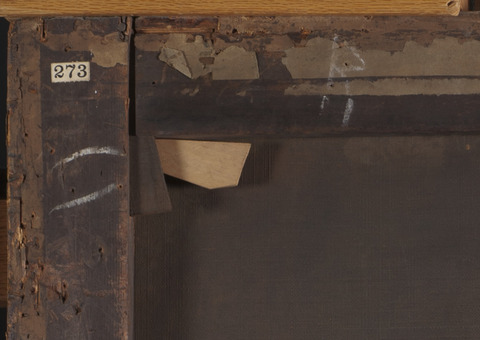
Summary of Treatment History
There are no conservation records for treatment of the painting from before the time the work was loaned to the IMA in 1971. However, physical evidence suggests the painting has undergone numerous interventions prior to its arrival at the IMA. The painting was previously lined, harshly cleaned, varnished, and retouched.
Documentation suggests a series of condition assessments and treatments were carried out on the collection about the time the works were moved from the Clowes residence to the IMA in 1971. A condition report by Paul Spheeris in October of that year, likely carried out before the paintings were relocated, described the painting as “O.K.” He recommended cleaning for the sake of the work’s appearance but not for its safety.1 A second condition assessment was carried out upon arrival of the paintings at the IMA. This assessment describes the work as being in good condition, and no work was deemed necessary.2
In 1974, a condition assessment, treatment, and investigation of the collection was carried out by the Intermuseum Conservation Association at Oberlin College. Their report describes this painting as having a “natural resin varnish with marked bloom, grime, and a high gloss finish.” It was recommended that it be superficially cleaned and coated.3 A memorandum explaining the charges for this work suggest the recommended work was indeed carried out.4
The painting was examined in the Clowes Collection annual survey from 2011 to 2018.
Current Condition Summary
The painting is generally in poor condition. The paint layer is severely abraded in several areas. Excessive heat and moisture was used in the lining procedure, flattening the work and causing weave interference. There are several layers of discolored, cloudy varnish on the painting that make it difficult to appreciate the image. There is also discolored retouching.
Methods of Examination, Imaging, and Analysis
| Examination/Imaging | Analysis (no sample required) | Analysis (sample required) |
|---|---|---|
| Unaided eye | Dendrochronology | Microchemical analysis |
| Optical microscopy | Wood identification | Fiber ID |
| Incident light | Microchemical analysis | Cross-section sampling |
| Raking light | Thread count analysis | Dispersed pigment sample |
| Reflected/specular light | X-ray fluorescence spectroscopy (XRF) | Fourier-transform infrared spectroscopy (FTIR) |
| Transmitted light | Macro X-ray fluorescence scanning (MA-XRF) | Raman microspectroscopy |
| Ultraviolet-induced visible fluorescence (UV) | ||
| Infrared reflectography (IRR) | Gas chromatography–mass spectrometry (GC-MS) | |
| Infrared transmittography (IRT) | Scanning electron microscope -energy dispersive X-ray spectroscopy (SEM-EDS) | |
| Infrared luminescence | Other: | |
| X-radiography |
Technical Examination
Description of Support
Analyzed Observed
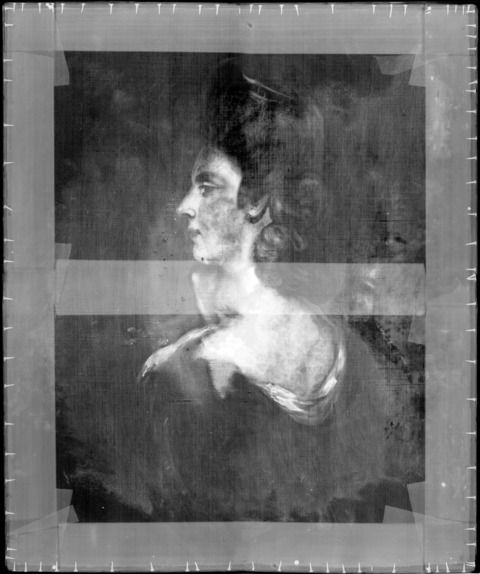
Material (fabric, wood, metal, dendrochronology results, fiber ID information, etc.):
The painting is on a tightly woven twill-weave canvas (tech. fig. 2). The tacking margins have been removed, and the painting has been glue-paste lined to a plain-weave canvas.
The dimensions of the original canvas are 75.5 × 64.3 cm. These dimensions conform to the “bust or three-quarter” size used by Reynolds and his studio.5 The original canvas extends all the way to the left edge and top edge of the face of the painting. On the right edge, the original canvas extends almost to the edge, leaving a 0.7 cm strip of only the lining canvas and nonoriginal paint. On the bottom edge, the original canvas does not extend all the way to the edge, leaving a 0.5 cm strip of non-original paint along the bottom edge.
The lining appears to date to the mid-nineteenth century (see Auxiliary Support). The tacking edges are covered with severely degraded paper tape that was likely put on after lining. This tape extends onto the face of the painting and over the edges of the original canvas.
Characteristics of Construction / Fabrication (cusping, beveled edges of panels, seams, joins, battens):
There is no evidence of cusping on the painting, but the work does not appear to have been significantly reduced in size when compared to a version of a similar composition in the Tate collection.6 The Tate version of the composition is also painted on a twill-weave canvas.7 Reynolds and his studio began using twill-weave canvases in the 1770s, and after 1780, they generally preferred twill weave.8
Thickness (for panels or boards):
N/A
Production/Dealer’s marks:
None
Auxiliary Support:
Original Not original Not able to discern None
The auxiliary support is a five-member stretcher with bridal joints and a half-lapped cross member. The stretcher is not original to the painting and likely dates to the early nineteenth century.9 Until the mid-eighteenth century, canvases were stretched on nonexpandable strainers. Paintings from Reynolds’s studio that are on original stretchers have corner braces and are much less robust than that of the Clowes painting.10 The stretcher has ten keys, one of which is missing.
Attachment to Auxiliary Support:
The canvas is attached to the stretcher with metal tacks. The tacks are machine cut with irregular heads, which suggest the work was stretched in the first half of the nineteenth century.11 The lining canvas extends around the edges of the stretcher where it is tacked, and to the back. There are several holes in the tacking margins and stretcher that do not currently have tacks in them. These may be damages from a previous framing mechanism.
Condition of Support
The original canvas is in generally stable condition, despite having the tacking margins removed. There is a small tear in the canvas over the figure’s ear, which may have prompted the work to be lined (tech. fig. 2). The lining canvas is old and brittle, but the painting has good tension on the stretcher and is in plane. There is a small damage to the tacking margin of the lining canvas on the lower-right corner of the painting.
The stretcher is generally in good condition. There are several small splits on the upper member and a split near the upper joint of the left stretcher. These splits do not compromise the structural integrity of the stretcher. The stretcher is slightly keyed out (0.5 cm in the top corners and 0.25 cm in the bottom corners). One of the keys in the upper-right corner is missing, and in the upper-left corner, a new key has been used to replace an older one.
Description of Ground
Analyzed Observed
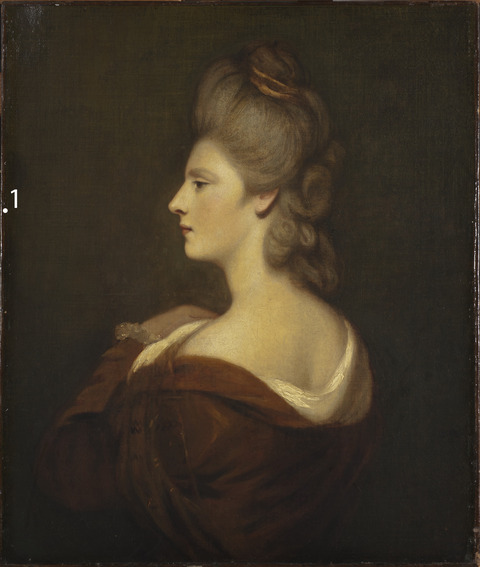
Materials/Binding Medium:
Oil (untested)
A cross-section sample was taken from the left edge in the background of the figure (tech. fig. 3). The ground is composed of two layers; the first (tech. figs. 4, 5, layer 1; tech. fig. 6) is a calcium carbonate-containing ground, and the second (tech. figs. 4, 5, layer 2; tech. fig. 6) contains a mixture of calcium carbonate and lead white. There are also several particles of silicon-rich earth pigments in layer 2.
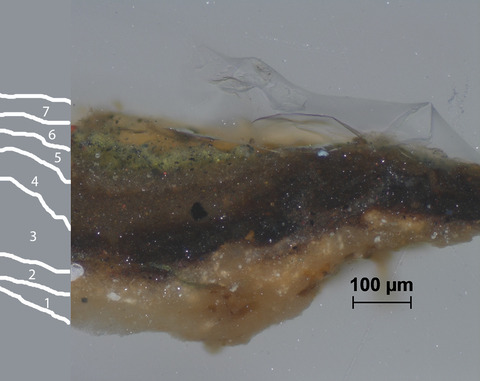
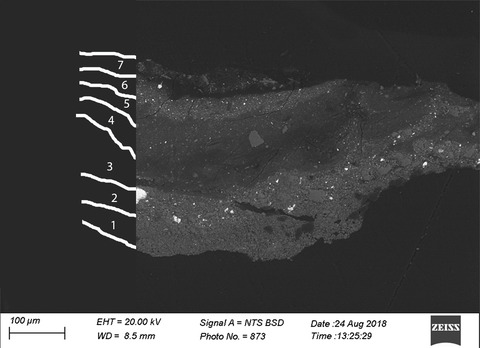
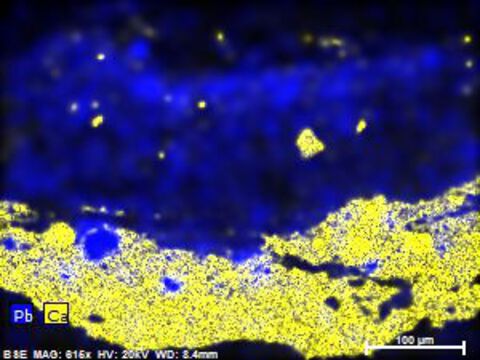
Color:
Off-white
Application:
The ground is applied in two layers. It is unclear if one or both of the ground layers are commercially applied.
Thickness:
The ground is applied quite thickly and masks the twill weave of the canvas.
Sizing:
None observed
Character and Appearance (Does texture of support remain detectable / prominent?):
The ground appears to have been applied quite thickly so as to obscure the weave of the canvas. However, the lining has caused weave interference, making the canvas weave visible.
Condition of Ground
The ground is in generally stable condition. There are a series of small losses throughout the painting, including in front of the woman’s face, on her chin, on her ear, and around the edges of the painting. These losses have not been filled, but they have been filled with varnish and inpainted.
Description of Composition Planning
Methods of Analysis:
Surface observation (unaided or with magnification)
Infra-red reflectography (IRR)
X-radiography
Analysis Parameters:
| X-radiography equipment | GE Inspection Technologies Type: ERESCO 200MFR 3.1, Tube S/N: MIR 201E 58-2812, EN 12543: 1.0mm, Filter: 0.8mm Be + 2mm Al |
|---|---|
| KV: | 20 |
| mA: | 2 |
| Exposure time (s) | 150 |
| Distance from X-ray tube: | 36″ |
| IRR equipment and wavelength | Opus Instruments Osiris A1 infrared camera with InGaAs array detector operating at a wavelength of 0.9-1.7µm. |
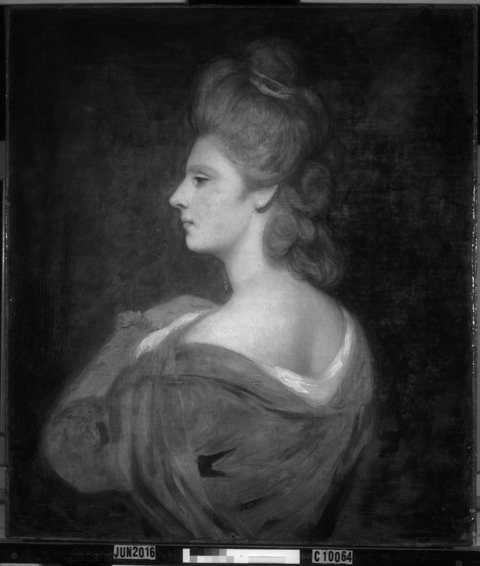
Medium/Technique:
Infrared imaging reveals a carefully planned underdrawing in what appears to be pencil (tech. fig. 7). The underdrawing outlines the profile of the figure’s face, features, contours of her hand and clothing, and curls of her hair. Most of the drawing is quite stiff and linear as if carefully following a previously established composition. Areas such as the ruff on the sleeve and curls of her hair are more freely drawn with some minimal hatching in the hair.
Pencil underdrawing was not used by Reynolds himself, who was known to work up his paintings with a few suggestive sketch lines and without making any preparatory sketches.12 Outlining in paint has been identified on several works including Strawberry Girl, where the outlining was carried out in a warm red paint. Pencil underdrawing has, however, been found on works from the Reynolds studio, including Lord Ligonier in the Tate collection.13
Pentimenti:
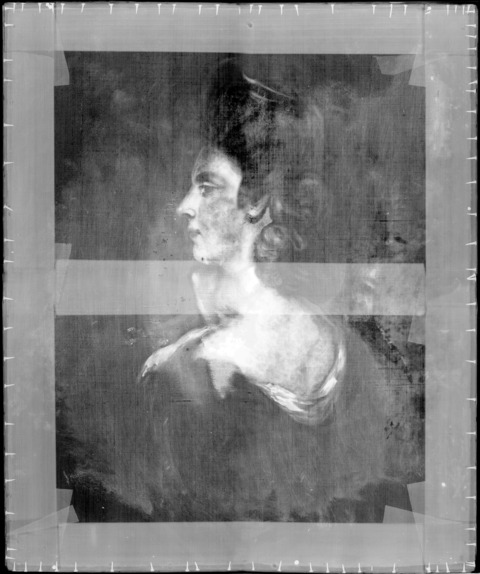
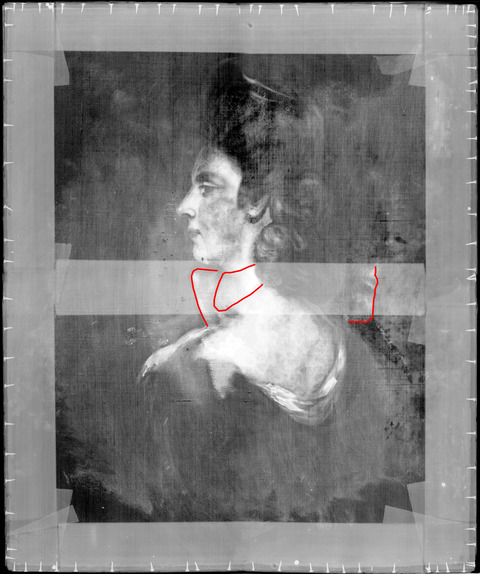
The X-radiograph reveals the head of a small child peeking over the woman’s proper right shoulder (tech. fig. 8). This composition matches that of the Tate version of the work. It also appears that the painter was working out the appearance of the child’s arm, as there is a triangular pentiment under the woman’s chin, which is difficult to discern. It may be the elbow of the child sticking up and what looks like the child’s arm in a different position wrapping around the woman’s neck. No other version of the work shows the child’s arm in this position. There is no evidence of underdrawing in the face of the child, but the infrared-absorbing background that is painted over the face may be blocking this area of the original drawing.
There also appear to be changes made to the shoulder and back of the woman, which were slightly wider in a previous version of the compostion.
The careful, stiff underdrawing contrasts with the numerous changes made during the painting stage, raising questions about how the work relates to the Tate version and how the work relates to the Reynolds studio.
Description of Paint
Analyzed Observed
Application and Technique:
The paint application is simple and flat. This may be a result of severe abrasion during a previous cleaning that likely removed glazes, but it is also in part due to the limited technical capability of the painter.
The artist appears to have followed the contours of the pencil drawing, blocking in the hair, skin, and drapery. The brown wash layer in the background seems to have been applied at this time as well. The features were painted by closely following the pencil drawing. A bright white midtone was applied in the skin using a bristle brush to thickly build up the paint with some texture. It was probably during this blocking-out stage that the pentimenti that are visible in the X-radiograph, including the child’s face and elbow, were painted. In the sitter’s cheek and ear, some red was added to the midtone to create modulation in the skin. Highlights and shadows were applied after the midtone, often in short hatching strokes with a finer brush. The shadows are opaque and chalky in appearance. In several instances, such as between the lips, nostril, and hand, a transparent red was used to deepen a warm shadow, but generally the shadows are not glazed and consequently often appear muddy and flat. The hand is very quickly painted using only the midtone to block out the form and a single line of transparent red to suggest the division between the thumb and fingers.
To give volume to the hair, the shadows appear to have been blocked in first followed by the highlights. Small strokes of paint were applied to give the illusion of individual strands of hair. This effect has been disrupted by abrasion.
The drapery was also painted following the contours of the pencil line using a larger brush to quickly establish the form. It appears that the drapery was blocked in after the skin using a directly applied midtone, shadow, and highlight to create form (tech. fig. 9). Again, in the drapery the shadows are flat and do not create rich depth.
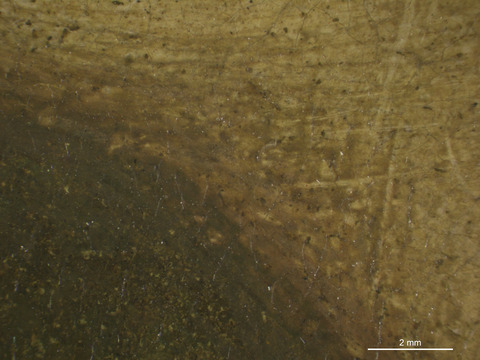
The green-blue layer of the background was applied after the skin and drapery were painted.
It is not entirely clear at which stage the changes to the composition that blocked out the child’s face and arm were made. Pentimenti are not visible in raking light, suggesting these changes were made early in the painting stage and subsequently covered by a thick application of background paint.
Painting Tools:
Brushes, medium and small
Binding Media:
Likely linseed oil (untested)
Color Palette:
The palette is primarily composed of earth tones with a greenish-brown background. XRF analysis was carried out on numerous locations across the surface of the painting (tech. fig. 10). These results suggest the painting was painted primarily with lead white, iron oxide (earth pigments), vermilion, and a copper-containing green and/or blue pigment in the background (Table 1).
XRF Analysis:
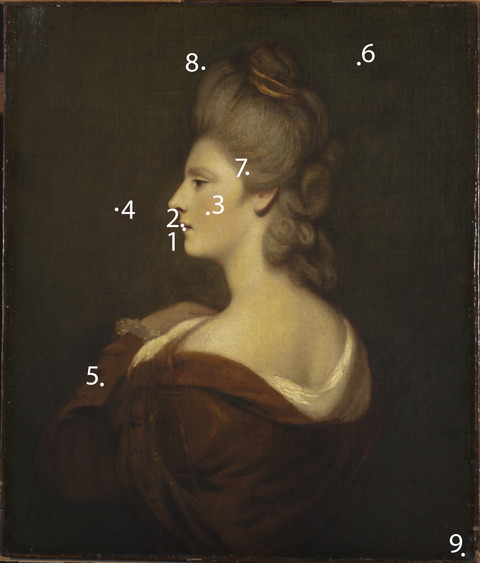
| Sample | Location | Elements | Possible Pigments |
|---|---|---|---|
| 1 | Bottom lip (29 cm down, 25 cm from left) | Major: Pb Minor: Hg Trace: Fe, Ca, Cu | Lead white, vermilion, iron oxide (earth pigments), trace of calcium (from ground layer), trace of copper-containing green and/or blue pigment. |
| 2 | Lip line (29 cm down, 25 cm from left) | Major: Pb Minor: Hg Trace: Fe, Ca, Cu | Lead white, vermilion, iron oxide (earth pigments), trace of calcium (from ground layer), trace of copper-containing green and/or blue pigment. |
| 3 | Cheek (28 cm down, 30 cm from left) | Major: Pb Minor: Trace: Hg, Fe, Ca | Lead white, trace of vermilion, trace of iron oxide (earth pigments), trace of calcium (from ground layer), trace of copper-containing green and/or blue pigment. |
| 4 | Background (28 cm down, 15 cm from left) | Major: Pb, Fe Minor: Cu Trace: Mn, K, Ca, Ba, Cr | Lead white, iron oxide (earth pigments including umber), copper-containing green and/or blue pigment, trace of calcium (from ground layer), trace of barium (likely from retouching), trace of chromium (likely from chrome yellow or chrome green retouching). |
| 5 | Red sleeve (28 cm down, 15 cm from left) | Major: Pb, Fe Minor: Trace: Cu, Ca, Zn, Mn, Ti | Iron oxide (earth pigments including umber), lead white, calcium (from ground layer), trace of copper-containing green and/or blue pigment, trace of zinc white (from retouching). |
| 6 | Background 2 (11.5 cm down, 51.5 cm from left) | Major: Pb Minor: Cu, Fe Trace: Mn K, Hg, Ca, Zn, Cr, Ba | Lead white, iron oxide (earth pigments including umber), copper-containing green and/or blue pigment, trace of calcium (from ground layer), trace of barium (likely from retouching), trace of chromium (likely from chrome yellow or chrome green retouching). |
| 7 | Hair (23.5 cm down, 33 cm from left) | Major: Pb Minor: Trace: Fe, Ca, Zn | Lead white, iron oxide (earth pigments), trace of calcium (from ground layer), trace of zinc white (from retouching). |
| 8 | Retouching (11 cm down, 25.5 cm from left) | Major: Pb Minor: Cu, Fe, Ca Trace: Mn, K, Zn, Cr, Ba | Lead white, iron oxide (earth pigments including umber), copper-containing green and/or blue pigment, calcium (from ground layer), trace of barium (likely from retouching), trace of chromium (likely from chrome yellow or chrome green retouching). |
| 9 | Retouching 2 (75 cm down, 63.5 cm from left) | Major: Pb, Fe, Cu Minor: Ca Trace: Mn, K, Ca, Zn, Ba | Lead white, iron oxide (earth pigments including umber), copper-containing green and/or blue pigment, calcium (from ground layer), trace of barium (likely from retouching). |
Table 1: Results of X-ray fluorescence analysis conducted with a Bruker Artax microfocus XRF with rhodium tube, silicon-drift detector, and polycapillary focusing lens (~100μm spot).
*Major, minor, trace quantities are based on XRF signal strength not quantitative analysis
Surface Appearance:
The surface appearance is severely abraded and flattened by past treatment. Impasto in the skin and drapery has been flattened. Weave interference is also visible throughout.
Condition of Paint
The paint layer is in generally poor condition. There is severe cleaning abrasion across the surface that has removed areas of shadow, leaving the surface pitted and the ground exposed (tech. fig. 11). There are several losses to the paint and ground as well as a tear in the earlobe of the woman that has corresponding paint loss (see Condition of Ground) (tech. fig. 12). The lining, which likely used excess heat and pressure, created weave interference on the front of the painting and flattened the impasto of the paint.
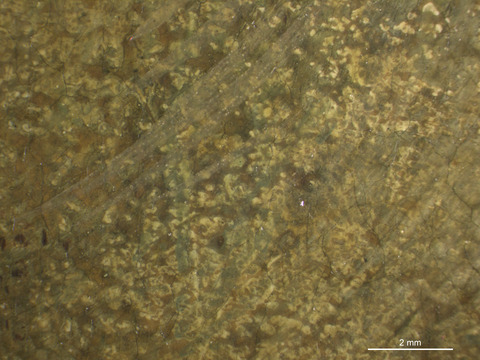
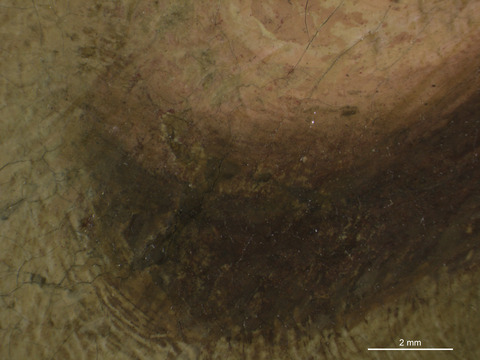
Description of Varnish/Surface Coating
Analyzed Observed Documented
| Type of Varnish | Application |
|---|---|
| Natural resin | Spray applied |
| Synthetic resin/other | Brush applied |
| Multiple Layers observed | Undetermined |
| No coating detected |
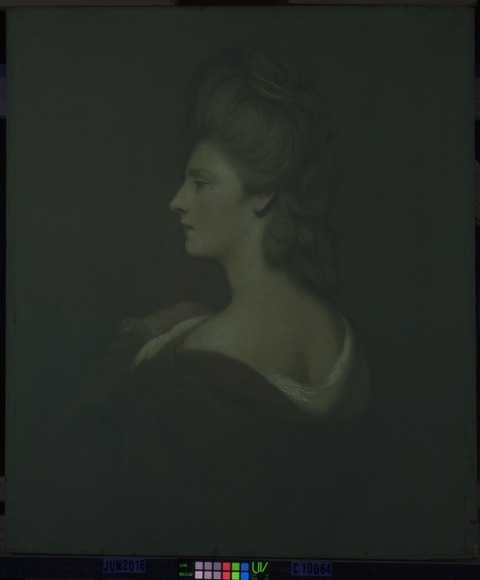
The painting has a thick varnish across the entire surface that fluoresces yellowish green in ultraviolet-induced visible fluorescence (tech. fig. 13). There are likely several layers of varnish. The upper layer extends over the paper tape, suggesting that it was applied after the painting was lined. Old, discolored inpainting is visible in the neck and face of the figure, the earlobe, and the background. The majority of the restoration appears to be under the upper layer of varnish as it is not visible under ultraviolet-induced visible fluorescence.
Condition of Varnish/Surface Coating
The varnish is very discolored and cloudy. There are streaks that seem more saturated than the generally cloudy varnish and appear as drips or swipes with a fingertip. The varnish is extremely glossy and thick. Old inpainting is mismatched and applied directly over the paint losses without filling.
Description of Frame
Original/first frame
Period frame
Authenticity cannot be determined at this time/ further art historical research necessary
Reproduction frame (fabricated in the style of)
Replica frame (copy of an existing period frame)
Modern frame
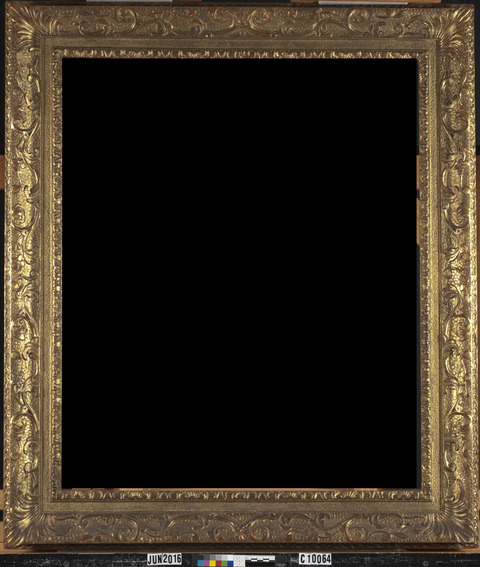
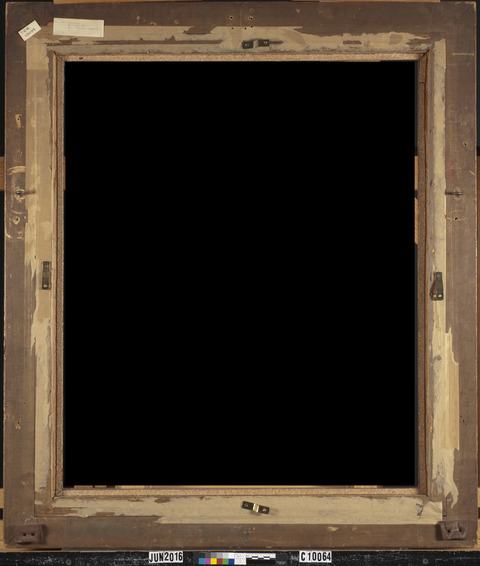
The frame is in the style of an eighteenth-century English frame (from about 1725), but it is likely a reproduction frame from England dating to the early twentieth century.14
Frame Dimensions:
Outside frame dimensions: 94.5 × 82 cm
Sight size: 74.5 × 61.8 cm
Rebate dimensions: 76.5 × W 65 cm
Distinguishing Marks:
Item 5. “No. 49—Reynolds/ Portrait of/ Mrs. Charles James Fox,” black, printed ink on white label, upper-left corner of frame (tech. fig. 15).
Item 6. “T.R. #/10064,” brown handwritten ink on white label, upper-left corner of frame (tech. fig. 15).
Description of Molding/Profile:
The frame is constructed from limewood and basswood covered with a deep red bole and gilded surface (tech. fig. 14). The sight edge has a pattern of acanthus leaves and shells and the outer edges have a pattern of paterae and darts. The frieze has a rough, sanded surface.
Condition of Frame
The frame is in good condition.
Notes
-
Paul A.J. Spheeris, “Conservation Report on the Condition of the Clowes Collection,” 25 October 1971, Conservation Department Files, Indianapolis Museum of Art at Newfields. ↩︎
-
Martin Radecki, Clowes Collection condition assessment, undated (after October 1971), Conservation Department Files, Indianapolis Museum of Art at Newfields. ↩︎
-
Intermuseum Conservation Association, “Clowes Collection Conservation Report,” C10064 (2017.89), 8–10 April 1974, Conservation Department Files, Indianapolis Museum of Art at Newfields. ↩︎
-
Memorandum from Carl J. Weinhardt to Martin J. Radecki, “Charges for Conservation of Objects in the Clowes Collection,” 15 February 1974, Conservation Department Files, Indianapolis Museum of Art at Newfields. ↩︎
-
A. Gent, A. Roy, and R. Morrison, “Practice Makes Imperfect: Reynolds’s Painting Technique,” National Gallery Technical Bulletin 35, (2014): 98, n10. ↩︎
-
The Tate version is 74.9 × 62.2 cm., http://www.tate.org.uk/art/artworks/reynolds-mrs-fox-n00891. ↩︎
-
Personal communication with Alexandra Gent, 21 June 2018. ↩︎
-
A. Gent, A. Roy, and R. Morrison, “Practice Makes Imperfect: Reynolds’s Painting Technique,” National Gallery Technical Bulletin 35, (2014): 14. ↩︎
-
This construction has been identified on early nineteenth-century stretchers, see illustration 13 in Mark Bockrath and Barbara A. Buckley, “Illustrated Historical Review of Stretchers and Strainers” in AIC Wiki: Stretchers and Strainers: Materials and Equipment (June 2007), https://www.conservation-wiki.com/wiki/Stretchers_and_Strainers:_Materials_and_Equipment#Illustrated_Historical_Review_of_Stretchers_and_Strainers. ↩︎
-
A. Gent, A. Roy, and R. Morrison, “Practice Makes Imperfect: Reynolds’s Painting Technique,” National Gallery Technical Bulletin 35, (2014): 14-15. For image, see A. Gent, “Reynolds, Paint and Painting: A Technical Analysis” in Joshua Reynolds Experiments in Paint, ed. Lucy Davis and Mark Hallett (London: Trustees of the Wallace Collection, 2015), 43. ↩︎
-
According to Goist, the technology for this type of machine-cut nail with irregular head dates to between 1825 and 1830. David Goist, “1.4, Historical Review of Nails and Tacks,” in AIC Wiki: Stretchers and Strainers: Materials and Equipment (October 2004), https://www.conservation-wiki.com/wiki/Stretchers_and_Strainers:_Materials_and_Equipment#Historical_Review_of_Nails_and_Tacks. ↩︎
-
W. Mason, “Anecdotes of Sir Joshua Reynolds, Chiefly Relative to His Manner of Coloring,” in Sir Joshua Reynolds’ Notes and Observations on Pictures, Chiefly of the Venetian School, Being Extracts from His Italian Sketch Books, ed. William Cotton (London: J.R. Smith, 1859), 50–51. ↩︎
-
Personal communication with Helen Brett, 27 June 2018. ↩︎
-
Timothy Newbery, frame specialist, London, England. Visual analysis completed at the Indianapolis Museum of Art, 19 January 2012. ↩︎
Additional Images

